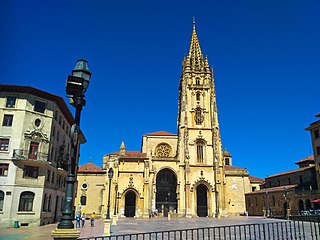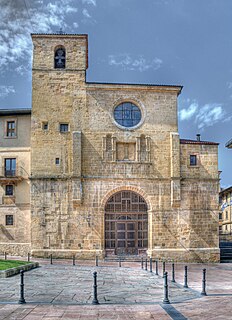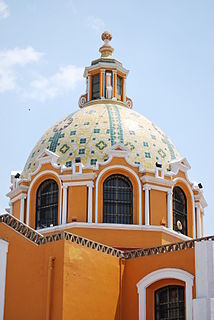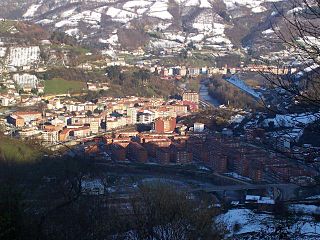
Covadonga is one of 11 parishes in Cangas de Onís, a municipality within the province and autonomous community of Asturias, in Northwestern Spain. It is situated in the Picos de Europa mountains. With a permanent population of 58 (2008), it consists essentially of the "Real Sitio de Covadonga"/"Real Sitiu de Cuadonga" also known as the "cradle of Spain", a pilgrimage site dedicated to Our Lady of Covadonga/Cuadonga and commemorating the Battle of Covadonga of 718/722.

Oviedo is the capital city of the Principality of Asturias in northern Spain and the administrative and commercial centre of the region. It is also the name of the municipality that contains the city. Oviedo is located approximately 24 km (15 mi) southwest of Gijón and 23 km (14 mi) south of Avilés, both of which lie on the shoreline of the Bay of Biscay. Oviedo's proximity to the ocean of less than 30 kilometres (19 mi) in combination with its elevated position with areas of the city more than 300 metres above sea level causes the city to have a maritime climate, in spite of it not being located on the shoreline itself.

San Vicente de Oviedo is a church and monastery in Oviedo, Spain. Its foundation, in 761, is recorded in a charter known as the Pacto monástico de Oviedo a copy made in the 12th-century of the original that is dated 25 November 781 and is considered the earliest document on the monarchy of the Kingdom of Asturias, although doubts exist as to the veracity of this document since the monastery, also called Antealtares in the Middle Ages, is not mentioned again until 969. According to the charter of 781, twenty years before, in 761, the monks Máximo, with his serfs, and Fromestano, founded a church in locum quod dicunt Oveto, which was to become the city of Oviedo. Fromestano and Maximo are considered the founders of the city and church. Fromestano in the charter of 781, describes its founding:
I, Frómista (Fromestano), abbot for the past twenty years, together with my nephew Máximo the monk, settled in this place, abandoned and uninhabited, founding a basilica in honor of Saint Vincent, a martyr of Christ and a deacon.

The Metropolitan Cathedral Basilica of the Holy Saviour or Cathedral of San Salvador is a Roman Catholic church and minor basilica in the centre of Oviedo, in the Asturias region of northern Spain.

The Roman Catholic Diocese of Mondoñedo-Ferrol is the northernmost of the four Latin rite suffragan dioceses in the ecclesiastical province of the Metropolitan Archdiocese of Santiago de Compostela, which covers Galicia in North-western Spain. The area had previously been home to Britonia, a settlement founded by expatriate Britons in the wake of the Anglo-Saxon invasion of Britain. Britonia was represented by the diocese referred to as Britonensis ecclesia in sources from the 6th and 7th centuries.

Almagro is a town and municipality situated in Ciudad Real province, in the autonomous community of Castile-La Mancha, Spain. A tourist destination, Almagro is designated a Conjunto histórico, a type of conservation area.

Spanish Gothic architecture is the style of architecture prevalent in Spain in the Late Medieval period.

El Salvador's approximately 6.2 million inhabitants are mostly Christian. Evangelical Protestantism is experiencing rapid growth in recent decades while the Catholic share of the population is on decline.

The Archdiocese of Oviedo is an Archdiocese of the Roman Catholic Church in Spain. The archdiocese encompasses roughly the current autonomous community of Asturias or Principality of Asturias. Erected in the 9th century, the diocese was elevated to an archdiocese in 1954. The diocesan see is in the city of Oviedo, where the Catedral de San Salvador is located.

San Sebastian is a redundant church in Toledo, Spain. The building was originally a mosque and was converted for use as church after the Reconquista. It is protected by the heritage listing Bien de Interés Cultural.

The Church of Saint Thyrsus is a Roman Catholic Asturian Romanesque church situated in Oviedo, in Asturias, northern Spain. The church was established in the 790s. Dedicated to Saint Thyrsus, it was built by Tioda, the royal architect of Alfonso II of Asturias. The Great Fire of Oviedo in 1521 and rebuilding in the 18th century removed most of the original church, except for a three-light window.

Saint Peter of Nora is a Roman Catholic Pre-Romanesque church, located in Las Regueras, Asturias, Spain, beside the Nora river, about 12 km from Oviedo. The church is recorded for the first time in a donation document of Alfonso III of Asturias in 905.

The Abbey of San Juan Bautista de Corias is a former Benedictine monastery in Corias in Cangas del Narcea (Asturias), Spain, on the right bank of the Narcea River, dedicated to Saint John the Baptist. Today it is a historic site of the province, informally known as "the Asturian Escorial", due to the burial there of King Bermudo I of Asturias and his family.

The Iglesia de Nuestra Señora de los Remedios is a 16th-century Mexican Catholic parish church built atop the Tlachihualtepetl pyramid in the municipality of Cholula located in the central Mexican state of Puebla. The church was built with carved stone and embellished with 24-carat gilded panels and shims, called laminilla. It has an altar in the neoclassical style. It was built between May 1574 and August 1575 and consecrated on March 25, 1629. The base on which the church is built one of the largest pyramids of the ancient world, being 54 metres (177 ft) high, covering 54 acres and shaped by several superimposed structures over the course of six centuries.

The Pantheon of Asturian Kings is a chapel of Nuestra Señora del Rey Casto in the Cathedral of San Salvador, Oviedo, Spain. It is the burial place of many of the rulers of the medieval kingdoms of Asturias and León.

Sotrondio is a town in San Martín del Rey Aurelio, Asturias, Spain. In September 2007, by a decree of the Principality of Asturias, it joined the adjacent El Entrego and Blimea to form a single population center, San Martin del Rey, as a homonymous municipality. It is 30 kilometres (19 mi) from Oviedo. The population was 3,849 in 2009, fewer residents than in previous years, declining due to the crisis of industrial restructuring in the Asturian coalfield. It is crossed by the Nalón River separating the Serallo neighborhood from the rest of the town. Aurelius of Asturias is believed to be buried at Iglesia de San Martín de Tours, which is near Sotrondio. It is the local parish church and was rebuilt by Duro Felguera after the Spanish Civil War. Teatro Virginia is located in the Plaza de Ramón y Cajal.
The following is a timeline of the history of the city of Oviedo, Spain.

Andrés Amaya was a Spanish Baroque painter in oils of religious subjects. He was active in the region of Castile and León, primarily in the city of Valladolid.

















